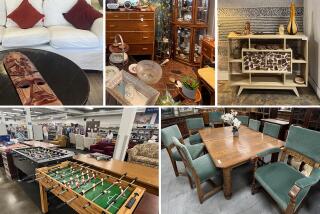Tried and True Old Is What’s New in Santa Fe
- Share via
SANTA FE, N.M. — It is almost impossible to leave Santa Fe without wanting to take the place home with you. This town is jewel-like. The low, earth-colored adobe buildings, some vintage and some built recently in accordance to the town’s strict codes, have an appealing unity of style.
Founded in 1609, this is the second-oldest city in the United States. It has maintained its colonial charm, while sacrificing neither modern conveniences nor sophistication.
The town has no codes covering interior decoration, but Santa Fe stylists have established an appealing blend of decorative elements. The hotels, restaurants and homes are filled with furniture and accessories that reflect the history and cultural mix--Spanish, English and Indian--of New Mexico. Decors include simply styled, handcrafted pine wood furniture, tiles, hand-loomed rugs--often in the muted, earthy and subtly varied tones of the desert.
Much of the furniture is contemporary, but replicates antique pieces made by frontiersmen. Seventeenth-Century furnishings are not available as models because few survived the torching of Spanish structures during the 1680 Pueblo Revolt, but there are many handsome examples from 18th and 19th centuries. Antiques are increasingly rare and expensive, in a seller’s market that is closely monitored by museums and wealthy collectors. The replicas, some with modernizing modifications, are a solution for people who love the look but cannot afford a certificate of authenticity.
Several Santa Fe workshops reproduce antique furniture by using the materials, techniques and skill that went into originals that were made back when times were hard, settlers were few and far between, and a family made its own beds, tables and benches out of ponderosa pine and other local materials with relatively primitive tools. Furniture was functional, built to last, and decorated with low-relief and cut-out patterns.
Beautiful Results
Contemporary Santa Fe furniture makers work with similar methods and goals. The results are beautiful. While they are ideally suited for Santa Fe adobe architecture, they work well in ranch homes or barn-like commercial spaces that have been converted into residences.
One of the best sources is Taos Furniture, 232 Galisteo St., (505) 988-1229, a company that makes about 60 models, each a slightly modified copy of an antique piece. Founded in 1970, the company was taken over in 1978 by Bill Powell, a transplanted Angeleno.
The line includes the famous Taos bed ($1,900 and up), a deep couch with slatted sides. Cushions along the back and sides can be removed to make a comfortable bed. In Taos Furniture’s version, the wooden board has been replaced by a rope undercarriage to support the seat cushion/mattress, providing more give and comfort.
Similarly designed sofas (from $1,800) and love seats (from $1,600) complete the suite. Material used for covering cushions varies; many have geometric patterns reminiscent of Indian designs, others are pastel or earth-tone solids. There are also chairs, ottomans, nightstands, coffee tables, dining tables, benches, chests, bed headboards carved to look like sunrises (from $400), sideboards, doors and mirrors.
The collection includes traditional tall storage cabinets with interior shelves called trasteros (from $1,700) and pie safes, where pastries and baked goods were set to cool, with cutout cruciform patterns in the door panels for ventilation. There are also slatted benches and padre chairs (from $475), so-called because in olden days they were reserved for honored guests, such as the priest.
Taos Furniture also makes handsome desks, bookcases, wooden file cabinets and worktables for the office. And furniture can be custom-made.
Each piece of furniture is made in the workshop, which employs 25 craftsmen. Each piece is handcrafted, usually by one person. The process begins with the craftsman’s selection of wood from the company’s store. Wood is air dried and then placed in the company’s own specially designed kiln. Once selected, the wood is milled and cut into parts.
That Well-Worn Look
The craftsman assembles the pieces, using dowels, mortise and tenon. Nails were scarce in old New Mexico, and Taos Furniture duplicates traditional joining methods used by frontiersmen. The wood is planed by hand, rather than with sanders. Finally, the piece is taken to the stain shop, where rocks are used to scrape surfaces or to wear down corners. This method gives the pieces an aged look. Stains used are light in color, and enhance the natural qualities of the wood.
Other workshops that make Santa Fe-style furniture based on antique designs include Dooling Woodworks, 525 Airport Road, (505) 471-5956, and McMillan’s Woodworks, 340 Read St., (505) 983-5007. The workshops have catalogues.
Santa Fe Interiors, 214 Old Santa Fe Trail, (505) 988-2227, has a spectacular selection of Santa Fe-style willow furniture, including love seats (from $250), chairs (from $200), chaises (from $300) and beautiful ponderosa pine beds with headboards and footboards ($2,000 to $2,500). A good selection of rugs, pillows, huge chunks of weather-worn wood, vases and Indian drums are sold as accessories.
Tara Tucker Ltd., 137 E. Palace Ave., (505) 983-6913, has a treasury of bedroom furniture and accessories tucked into several small rooms. There are pine and cedar bedposts (from $350 to $1,150), an array of antique quilts, and wicker brooms that are undoubtedly better for decoration than for sweeping, although the salesperson assured me that they’re good for both. There are linens with eyelet borders that fit beautifully with the roughly hewn wooden bedposts, indicating that Santa Fe style no longer requires the hard times life style that once produced it.
The stores mentioned in this article will supervise shipping, so you will have no difficulty getting purchases home.


